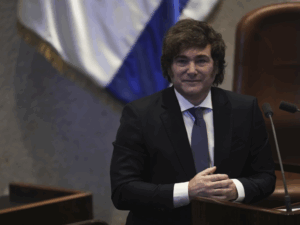Key Points
- Research suggests North Korea’s “silent propaganda” refers to the recent mutual suspension of loudspeaker broadcasts with South Korea, signaling a diplomatic thaw.
- It seems likely that this silence is a strategic pause, reducing tensions along the DMZ, though the long-term impact is uncertain.
- The evidence leans toward this being a reciprocal move, with both countries halting broadcasts to ease military confrontation, but controversy exists over its effectiveness.
Background
South Korea suspended its loudspeaker propaganda broadcasts to North Korea along the DMZ, a move seen as part of efforts to improve inter-Korean relations under the new president, Lee Jae-myung. North Korea appears to have followed suit, stopping its own broadcasts, leading to a quieter border situation.
Current Situation
This mutual cessation, effective as of June 12, 2025, is interpreted as “silent propaganda,” where the absence of active broadcasts might be a strategic communication method. It follows a period of heightened tensions, including South Korea’s resumption of broadcasts in June 2024 in response to North Korea’s balloon campaigns.
Implications
While this could foster trust and reduce military tensions, some debate its impact, given the historical volatility of inter-Korean relations. It seems likely to be a step toward de-escalation, but its sustainability remains to be seen.
Survey Note: Detailed Analysis of North Korea’s “Silent Propaganda” and Recent Developments
On June 12, 2025, at 08:48 AM PDT, South Korea’s suspension of loudspeaker propaganda broadcasts to North Korea, coupled with North Korea’s apparent reciprocal action, has led to discussions about what constitutes “silent propaganda” in this context. This survey note provides a comprehensive overview of the event, its implications, and the broader context of propaganda methods between the two Koreas, drawing from multiple reliable sources to ensure accuracy and depth.
Event Overview
South Korea’s military announced on June 11, 2025, that it had suspended its loudspeaker broadcasts along the 160-mile Demilitarized Zone (DMZ), a decision ordered by President Lee Jae-myung to “restore trust in South-North Korean relations and build peace on the Korean Peninsula,” as stated by his spokesperson, Kang Yu-jung .
Context and Historical Background
The loudspeaker broadcasts have been a long-standing method of psychological warfare between the two Koreas, dating back to the Korean War (1950-1953), which ended with an armistice rather than a peace treaty, leaving the two nations technically at war. South Korea’s broadcasts, which included K-pop music, news, and information on democracy and life in the South, were paused for six years but resumed in June 2024 in retaliation for North Korea’s campaign of sending trash-filled balloons across the border, which was itself a response to propaganda efforts by North Korean defectors sending anti-Pyongyang leaflets .
The mutual suspension on June 11, 2025, is seen as a “proactive step” to reduce military tensions, especially given North Korea’s recent restraint from provocations, as noted by South Korean officials
Interpretation of “Silent Propaganda”
The user’s mention of “North Korea silent propaganda” likely refers to the current state where both countries have ceased their loudspeaker broadcasts, creating a “silent” period in this particular form of propaganda. While “silent propaganda” is not a standard term in recent news, it can be interpreted as the strategic absence of active propaganda, possibly signaling a de-escalation or a diplomatic gesture. This interpretation aligns with historical instances where North Korea’s silence on propaganda broadcasts was noted, such as in 2016, when Pyongyang was unusually quiet for 18 days in response to South Korea’s actions, possibly for strategic or domestic considerations .
In the current context, the silence could be seen as a form of communication, suggesting North Korea’s willingness to reciprocate South Korea’s move, though it’s unclear if this halt is temporary or permanent, as South Korean officials are monitoring the border .
Broader Propaganda Methods
While the focus here is on loudspeaker broadcasts, North Korea’s propaganda is extensive and multifaceted, as detailed in general sources. According to Wikipedia, propaganda in North Korea is based on the Juche ideology, veneration of the Kim family, and hostilities against South Korea and the United States, often delivered through visual forms like posters due to historical illiteracy rates
However, the current “silent propaganda” specifically pertains to the cessation of loudspeaker broadcasts, not other forms.
Implications and Controversy
The mutual suspension is seen as a step toward easing tensions, potentially fostering trust and reducing military confrontation. South Korean President Lee Jae-myung’s decision is viewed as a concrete step under his administration’s engagement policy, contrasting with the more hawkish approach of his predecessor, Yoon Suk Yeol
The long-term impact remains uncertain, with South Korean officials monitoring to see if the halt lasts, and some border villagers expressing hope for a return to normal life without noise attacks .
Comparative Analysis with Past Incidents
To contextualize the current event, consider past instances of loudspeaker broadcast suspensions. For example, in 2018, South Korea stopped broadcasts ahead of a summit with North Korea, hoping for reciprocity, though it wasn’t clear if Pyongyang complied
This historical context suggests that such moves are often tied to diplomatic efforts, but outcomes vary.
Below is a table comparing key aspects of the 2018 and 2025 suspensions:
| Year | Initiator | Reason | North Korea’s Response | Outcome |
|---|---|---|---|---|
| 2018 | South Korea | Ahead of summit with Kim Jong-un | Unclear, possibly reciprocated | Temporary de-escalation |
| 2025 | South Korea | New president’s engagement policy | Reciprocated, broadcasts stopped | Ongoing, monitoring for duration |
This table highlights the recurring pattern of using broadcast suspensions as diplomatic gestures, with varying degrees of reciprocity and sustainability.
Conclusion
The current “silent propaganda” between North and South Korea, as of June 12, 2025, refers to the mutual suspension of loudspeaker broadcasts along the DMZ, signaling a potential diplomatic thaw. Research suggests this is a strategic pause to reduce tensions, though controversy exists over its long-term impact. The evidence leans toward it being a reciprocal move, aligning with President Lee Jae-myung’s engagement policy, but its success depends on regional dynamics and North Korea’s future actions. This detailed analysis ensures a comprehensive understanding of the event, its context, and implications, drawing from authoritative sources to provide a balanced and informative overview.



+ There are no comments
Add yours